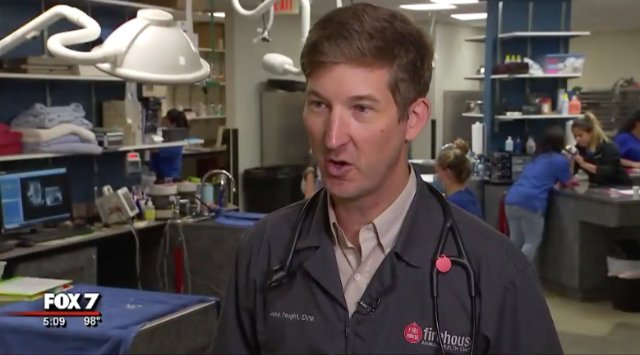3 minute read
Dr Natalie Davis recalls the scary day her dog Dakota got sick after they spent the afternoon paddle boarding on Lady Bird Lake. Dakota was acting strange during the car ride home: she was tired, threw up, and wasn’t acting herself.
Even though Dakota never swam, Dr Davis called her veterinarian (this was before she was a vet). “Luckily, she was simply dehydrated and tired after a long day,” says Dr Davis.
As summer heat intensifies in Austin, pet owners should know about the presence of blue-green algae in our local lakes and rivers.
Naturally occurring in many Texas waterways, blue-green algae produce toxins that are harmful to animals and humans. In some cases, it can lead to the death of your dog. Dr Davis has advice to keep your dog safe this summer (and year-round).
Cat owners can rejoice—this isn’t an issue you must worry about. 😊 “I wouldn’t put it past Austin,” says Dr Davis, “but I’ve never seen a swimming cat. So, cat owners need not worry.”
What is Blue-Green Algae?
Blue-green algae is a toxic-to-dogs bloom in Texas lakes and rivers. It’s also toxic for humans. While this alga is most prevalent in the hot summer months, it tends to stick around all year thanks to our warm Central Texas climate.
Blue-green algae looks like a green film on the water’s surface. In Austin, Lady Bird Lake and Lake Austin have been affected by blue-green algae blooms since 2019.
Luckily, contact with the algae doesn’t make your dog contagious. It also can’t be passed from pet to pet or pet to person.
How can you protect your dog from blue-green algae?
Keep your dog safe by avoiding areas with algae blooms. The City of Austin monitors our waterways year-round. We also link to this site on our website resources page.
Check the City’s reports to decide whether you’ll bring your dog boating, kayaking, or paddle boarding. “Before you head out on an adventure, check (these sites) to make sure you know what’s going on,” says Dr Davis.
The City of Austin advises we treat all algae like it’s toxic. They also note that these algae blooms are still present as Central Texas weather cools.
What should you do if your dog touches or drinks blue-green algae?
If your dog swam in affected water, symptoms include:
- Vomiting
- Diarrhea
- Foaming at the mouth
- Loss of appetite
- Stumbling
- Muscle twitches that increase in frequency
- Difficulty breathing
Please call us if you think your dog swam in a lake with blue-green algae.
If your dog has symptoms of poisoning, we’ll conduct a thorough exam and may recommend additional diagnostics like lab work and imaging. Treatment is aimed at relieving your pup’s discomfort and pain. It’s also focused on letting the toxin pass through their body safely.
In serious cases, we’ll consult a toxicologist and/or refer you to a 24-hour care facility.
Rapid diagnosis and supportive care are the keys to getting your dog back to their happiest and healthiest selves. This lets the poison pass through the patient’s body quickly and with as little suffering as possible.
Proceed with caution
Stay cautious around all algae. Since it’s difficult to identify what type of algae you’re seeing, we recommend treating all algae as though it is toxic.
Check out our other blog about summer safety on local rivers and lakes. And these two write-ups filled with helpful tips about a common pantry toxin and next steps if your pet eats poison.
Dr Davis is now more cautious with her two dogs when enjoying summer afternoons on Austin lakes. She keeps informed and stays cautious.
Firehouse is here to help your dog enjoy a safe and happy summer. If you’re worried, please call us or book a visit through our online appointment tool.

